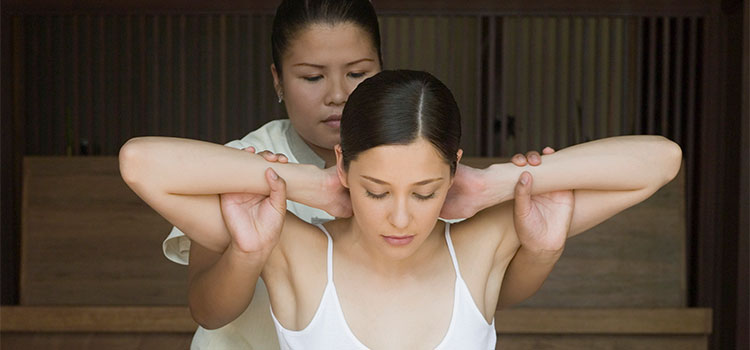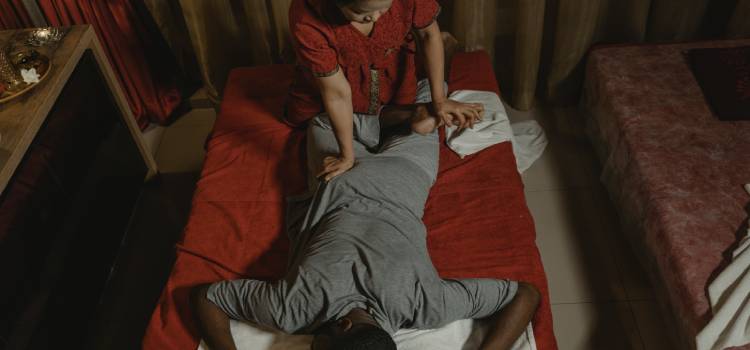In This Article

Rooted in Ayurvedic medicine, Thai bodywork, also called Thai massage or Thai yoga massage, combines stretching and body movements to loosen muscles, release tension and eliminate disease.
Through training at a Thai massage school, practitioners learn how Thai massage blends elements of yoga, energy healing, meditation, and acupressure to relax and invigorate clients, reducing their stress and tension and helping them achieve greater overall health and wellness, as well as spiritual balance.
Our guide to Thai massage certification, training, and career resources is aimed at helping you take the first step in learning Thai yoga massage and bodywork.
What is Thai massage?
Origins
Historians speculate that the origins of Thai massage therapy date back approximately 2500 years ago, to the work of an Indian doctor named Shivago Komarpaj (or Jivaka Buccha Komar) who is considered the “Father Doctor” across southeast Asia and was a contemporary of the Buddha.
Thai massage therapy, or Nuad Bo-Rarn in the Thai language, has undoubtedly evolved since his time and is thought to have been passed down orally through most of history.
What to expect in a session

Thai massage sessions are traditionally performed on a padded mat on the floor to give the practitioner better leverage in deep muscle stretching and joint release for the client. Using their hands, knuckles, elbows and feet, the practitioner employs a series of movements to stretch the client’s entire body and apply point pressure intended to open the body’s energy channels or sen.
Although Thai massage can be adapted to a table, it’s easier to do it on the floor so the practitioner can utilize their own body weight and gravity to perform the movements necessary to stretch the client’s body. Typical sessions last one to two hours, and clients remain fully dressed in loose, comfortable clothing.
An expert defines Thai bodywork
“It’s an energy-based modality like other Asian modalities,” said Janice Gagnon, a Thai massage therapist and founder of Spirit Winds School of Thai Massage where she is an instructor. “You use your whole body, and body weight. You use your feet, knees, elbows, and forearms in order to apply pressure. It’s a combination of compression and stretching and energy work, rather than effleurage and oil.”
Thai massage shares some similarities with yoga, and it’s common for yoga instructors to learn some Thai massage techniques to incorporate into their own practice. In Thai bodywork, however, the client takes a passive rather than active role.
Benefits of Thai massage therapy
Physical benefits
Considered both a therapeutic and meditative treatment, studies show that Thai bodywork not only improves flexibility, circulation, and range of motion but also centers the body and mind. It can also help reduce muscle tension, chronic pain and digestive issues, as well as promote relaxation and deeper sleep.
Thai massage can also be beneficial to the practitioner since they are using their bodies in the movements. Rather than relying on their own muscle strength like in other modalities, it’s not as hard on the massage therapist’s own body and can be an invigorating experience for them, too.
Emotional and spiritual benefits
“I see that it can be a profound healing experience, not just physically but emotionally and spiritually as well,” Gagnon said. She thinks of Thai massage not as a one-way transaction from practitioner to client, but rather that the practitioner’s role is to guide the client into a state of being that relieves energy blockages in the body and allows the medicine to come through on its own.
Gagnon said that because of its Buddhist roots, Thai massage comes from an emotional approach where compassion and loving kindness is the healing force at work underneath it all, rather than just physical techniques.
“Another one of the main things that are different about Thai massage from other modalities, especially western ones, is that its intention is to expand consciousness. That also is coming from that Buddhist base—so if you think of it being given in a container to facilitate a meditative state, that is how it expands consciousness. Then the medicine of the tradition comes through in whatever way that person needs,” Gagnon said.
Training and educational requirements
Specialized Thai massage schools and traditional massage therapy colleges offer training in Thai yoga massage. The best way to become a Thai massage therapist is to complete a training program so that you can learn the techniques through hands-on practice.
When you are looking for a Thai massage program, it’s a good idea to check out schools that are approved by reputable organizations such as the National Certification Board for Therapeutic Massage and Bodywork (NCBTMB) and/or the Thai Healing Alliance International (THAI). Approval from these organizations shows that the school or program demonstrates a standard of excellence set by the organization.
That being said, some programs don’t seek approval from organizations like these because they don’t want to pay the fees required to be reviewed and approved. Just because a program is not approved does not mean you can’t get a quality education, but approved schools are always a good place to start.
For the most part, you do not need any prior massage therapy or other bodywork training in order to begin a Thai massage program. Gagnon said that she gets a combination of students at her school—some who have massage experience already, and some who are brand new and just want to learn Thai massage.
What you’ll study in Thai massage school
While the content does vary depending on the program, you can typically expect Thai massage certification programs to cover these courses:
Many Thai massage training programs offer multiple levels of courses that scaffold off one another. It’s common for them to be structured as levels one through five, or beginner through advanced.
As you progress through the sequence, you build upon the knowledge of previous courses and continue to learn new information. Every school structures its program differently.
A typical curriculum might look like:
Level 1
Introduces students to Thai massage therapy. Students learn the foundations of Thai massage history, philosophy and basic techniques.
Level 2
Teaches more techniques, stretches, and poses. You may also begin learning more about sen energy lines in the body.
Level 3
Students start learning about traditional Ayurvedic and Thai medicine and how it relates to Thai massage.
Level 4
Continue to learn more massage poses and techniques, and review topics from previous levels.
Level 5
A deeper dive into all ten major sen energy lines and how to incorporate them into your practice.
It’s common for some schools to offer additional add-on classes that focus on a particular topic that may be beneficial to your practice, such as:
Some schools offer these courses individually, meaning you can pick and choose which you want to take. This could be beneficial for those who want to try out an introductory course before committing to the full program, or someone who already has experience in Thai massage therapy may skip ahead and start at an intermediate or advanced course. However, some schools may only award you with a certificate of completion if you complete the full sequence.
Although it’s not always taught traditionally, Gagnon suggests taking classes at some point to gain a more anatomical, scientific understanding of the modality.
“It’s always best to add some more knowledge because we are living in a western world, and we do want to be aware of the needs of our clients that live here. They feel they have more trust and feel safer if someone also knows anatomy and understands the function of the techniques they are doing from that more therapeutic value, not only just because it feels good.”
Average length of study
Thai massage school programs usually involve around 150-250 hours of training, plus a specified number of practice sessions given to clients. Gagnon said that if you want to continue your education, she suggests taking classes from a variety of schools and teachers.
“It’s something you can keep adding to your whole life. That is one thing about Thai massage, there’s such an amazing wealth of techniques and styles and teachers that you can continue for the rest of your life to add things and keep learning.”
Average tuition
Tuition for Thai massage school programs varies widely. Since many programs have multiple levels of classes, you may be able to take some classes individually rather than the entire program. You can expect to pay around $3,000 to $6,000 total for a full Thai massage school program. Many schools allow you to take classes on your schedule, giving you the time to absorb class teachings and conduct hands-on practice sessions.
Thai massage certification
There is no official certifying body for Thai massage therapists specifically, however, certain organizations have their own standards for Thai massage practitioners. Thai massage schools set their own curriculum where, upon completion of their program, you are considered certified by their standards.
Thai massage therapists do have the option of becoming an Registered Thai Therapist (RTT) through THAI. This voluntary credential can be achieved by completing 250 hour or more of hands-on study of traditional Nuad Bo-Rarn Thai massage. According to Gagnon who has been on the executive council for THAI, this credential is gradually being phased out and will eventually not be available, though it is still available at this time.
Licensure
Most states require massage therapists—regardless of your chosen massage modality—to have a license to practice. Licensure requirements vary by state, but in many cases, you need to complete an approved massage therapy program with a certain number of hours of hands-on massage therapy practice and pass a national or state exam. Be sure to research your state massage board’s requirements to find out what the massage laws are in your state.
Pay and employment outlook
The pay range for massage professions, including Thai yoga massage, can vary widely. Practitioners can often increase their salary over time as they accrue a reliable client base and invest in more education and training.
The U.S. Bureau of Labor Statistics (BLS) estimates that massage therapist professions, like Thai bodywork, can anticipate much faster than average employment growth—18.3%—through 2031.
The increasing popularity of complementary and alternative medicines, touch therapies and self-care as paths to overall health and wellness are among many factors that may contribute to the strong job growth for massage professions over the next several years.
More and more medical professionals are recognizing the health benefits of massage as well, which could contribute to an increase in the employment of massage professionals in the field of healthcare.


